Growing Strawberries from Plants, Seeds or Runners
Whether growing strawberries for profit or pleasure, learn how to grow strawberries and a growing guide for organic strawberry plants by seeds or runners. Strawberries are one of the best cash crops for small farms. Even in the height of the growing season demand is always larger than supply and so therefore an excellent money fruit crop. Even at times when strawberries are cheap, what they have cost you to produce will still ensure a good profit.
Strawberries have one of the highest levels of pesticides when grown commercially. If you want to see just how many toxic sprays are used on conventionally grown strawberries - prepare to be horrified. See our page entitled 4 reasons for growing organic strawberries. We don't need commercial pesticides to grow beautiful strawberries.
To grow strawberries for profit there are 3 things you need to take into account:
- The strawberry plants should be high yielding and this is determined by chosing the correct variety
- The strawberry plants should be well looked after
- The strawberry fruit should be handled and picked with care
There are 3 main types of strawberries:
1) Summer-Bearing Strawberry Varieties
2) Day-Neutral Strawberry Varieties
3) Ever-bearing Strawberry Varieties
Growing Summer-Bearing Strawberries
1) Summer-bearing strawberries produce just one large crop of fruit during the summer of every year, generally in June or July in the northern hemisphere. Another name for these varieties are "Short Day Strawberries" because it is the short days of fall that encourage the plants to make flower buds.
Although these berries are the largest of all the 3 types they do have the most problems with soil-borne diseases, so can be difficult to grow this type of strawberry organically, although not impossible.
2) Day-Neutral strawberries are the opposite end of the spectrum. These berries bear fruit all throughout the year, as long as the climate is good and temperatures are below 90º F. In places where the climate is mild you can guarantee growing strawberries all year round. However, if not, then you can expect to harvest your berries from late May until the frosts come if you live in the Northern Hemisphere.
Growing day-neutral strawberries is a good choice for growing in containers as they like to live close together with their neighbors and don't produce runners. They are also a good-sized berry; medium to large with a good taste. One of my favorite varieties is "Albion" as it is one of the best strawberry varieties for organic strawberry growing giving very little trouble and with a great resistance to soil-borne diseases.
3) Ever-Bearing strawberries give 2 crops; one in spring and the other in late summer / fall. However, after 3 years it is best to remove the plants and replant with new strawberry plants as the number of strawberries you are able to harvest will start to decline, the plants will become weaker and more prone to disease. They produce a medium sized berry and seldom send out runners, so also suitable for growing in containers.
GROWING STRAWBERRIES - Climate
Strawberry growing can take place in a wide variety of soils and climatic conditions from the topics to cooler climes. Just make sure that you choose a variety that will grow well in your area.In the Southern Hemisphere you can plant your strawberry plants out in April if you live in tropical areas and can harvest in winter and early spring. In cooler areas, plant in late winter and early spring if you live in a frost-free area. If not, plant after the danger of frost has passed and harvest in the summer.
GROWING STRAWBERRIES - Soil and Conditions
There is a very general impression that light, dry, sandy soils are the best for the strawberry. In fact, it's just the opposite. Strawberries love moisture so much that it is almost an aquatic plant. Having said that, they don't like to have pools of water lying around it at any time. However, those juicy strawberries are those that have had a steady supply of water during the times that they needed it.
The ideal soil for growing strawberries should be rich and slightly acidic, with plenty of well-rotted manure and compost to keep the moisture in. Ideal growing conditions for the strawberry plant is a pH of anywhere between 5.5 - 6.8.Strawberries seem to prefer cow manure to others, although they will also thrive on horse manure if cow manure is not available. Manure from the horse-stable, therefore, is almost doubled in value as well as bulk if composted with leaves, muck, or sods, and allowed to decay before being used. But whatever farmyard manure is used, it must be well-rotted.
If you are growing strawberries for profit then you will need to make sure that you prepare your beds well in advance, at least 1 year in advance where a heavy application of farmyard manure should be added to the soil and well mixed. This will add humus to the soil and improve its fertility. This is bed done in the fall.
The soil should also drain well, still retain good moisture levels, but not be soggy.
Cover crops that can be planted on the soil to be used for growing strawberries are buckwheat, oats, clover or hairy vetch.
Strawberry plants should be planted in
an
open sunny
area
where they will crop profusely under the right conditions.
Also make sure that the position gets good air-circulation as
strawberries can be affected by fungal diseases. They will also
tolerate some shade although they don't like
dense shade. Keep strawberries moist. You'll need to water your
strawberries twice a week, unless it rains. To prevent fungal disease water in the mornings only.
Liquid fertilizer is an excellent foliate feed for growing strawberries, especially liquid seaweed during their crucial flowering period. They also like fish fertilizers or a manure tea made again with well rotted cow manure.
Growing strawberries in containers is very possible and you can use cut down wine barrels, place strawberries in hanging baskets where they make a lovely show, in purpose-built strawberry barrels or just in pots and containers on your veranda or patio. Don't grow strawberries in shallow containers though. Strawberry plants have long roots, and it is not uncommon to find some strawberries with roots of 2 feet!
If your soil is not deep enough you will get a good sized crop from the first flush, but all your strawberries will fruit together and the second flush will be small and small in number too.
As mentioned above, the day-neutral
strawberries are
the best varieties for growing in containers. They will flower and
fruit all season long.
Plant the container with one part
compost and 2
parts potting soil. Add some well-rotted cow manure. Remember when
growing strawberries
successfully having
sufficient potash is vital for a good
crop. Wood ash, not coal ash, is mixed into the soil at
the rate of 1
oz per square yard or seaweed meal at the rate of 3 ounces are great
for encouraging heavy cropping.
GROWING STRAWBERRIES - Best Companions
Grow strawberries with beans, lettuce and spinach. If you have a herb garden borage and strawberries grow very well together.
To improve the taste of your strawberries mulch with dry pine needles.
GROWING STRAWBERRIES - Best Planting Time
If you are thinking about growing strawberries where winters are very cold one should wait until the frosts have passed and plant strawberries out in early spring. However, if you don't have to worry about severe winters and your climate is mild, you can plant strawberries out in late summer, early autumn where the plants are left to fruit the following summer.If strawberry plants are planted in the spring, any flowers that emerge should be picked off to allow the plants to build up their strength for when they fruit the following year. Not only will the yield be greater the following year if this is done, but the number of runners that the plants will throw out will be greater too. Thus creating a greater opportunity for increasing the size of your strawberry patch.
GROWING STRAWBERRIES - How to Grow Strawberries by Seed
Although you can get strawberry seeds from your local garden center it takes some time to get them to a stage whereby you will benefit from picking your first harvest. However, if this is your only option, sow your seeds in early spring.The seeds are extremely small, so make sure that when you plant them you don't put too much soil over the top of them as too much soil will make it difficult for them to germinate successfully.
GROWING STRAWBERRIES - How to Plant Strawberries
When you buy strawberry plants the best time to plant the plants about a foot away from each other. Allow the roots be spread out, not buried in a mat, the earth pressed FIRMLY against them, and the crown of the plant be exactly even with the surface of the soil, which should also be pressed closely around it with the fingers.This may seem minute detail, but essential if you want to grow strawberries successfully. If you plant your strawberry plants too deeply the crown will rot, too shallow and the plant will dry out. See the picture below.
The plant in the middle is at the correct depth. The plant on the left is too high, and the plant on the right is too deep.
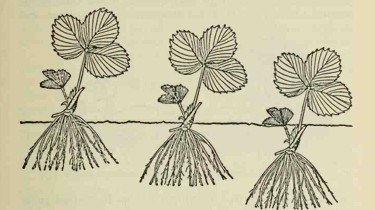
The Middle Strawberry Plant is Planted at the Right Depth
Spacing strawberry plants will be set 1 foot apart in the rows and then 3 feet away from each row.
I like to grow my strawberries like this because as they grow and spread they fill up the spaces and I can then spike the runners into the ground to get more plants next year. This is known as the matted system.
However, growing strawberries this way does have its drawbacks as when the runners grow and matt together you can have a devil of a job keeping the weeds down in this large bed. One way around this is to make sure that your beds are narrow enough so that you can get to the center of it without difficulty. 3- 4 feet in width is ideal as you can get to the center easily from both sides.
Some people prefer to grow single plants, cutting off the runners as soon as they appear. Certainly, it has the advantage of keeping clean rows as well as producing large fruit.
GROWING STRAWBERRIES - How to Grow Strawberries by Runners
The strawberry plants that you buy from the nursery will send out runners after they have cropped. More often than not they find their own patch of soil and send down roots without any help from the grower. This type of growing will result in a very densely planted strawberry patch.However, if you like your strawberries to be in regimented rows, select 2 or 3 of the best strawberry runners and cut off the rest. Place each new plant at the end of each runner in a small pot filled with good potting mix and compost. Once the plants have established their roots cut off the strawberry runners from the main plant, remove from the pots and plant out in their rows as before.
GROWING STRAWBERRIES - How to Look After your Strawberries
After you have planted your strawberry plants out they should be well watered in. Water daily until they are well established and then water at least 2 - 3 times a week depending on your climate and weather. It is best to water the strawberries in the evening at this stage. At no time should the soil be allowed to dry out.If you live in an area where the climate is severe in winter your strawberry plants will be affected. To prevent too much harm to your roots and crowns use straw to protect the plants. Apply layers of straw around the plants before the temperature falls to -7ºC or 20ºF.
You may also resort to putting cloches around your plants when growing strawberries to give them protection from the cold.
Some commercial growers will tell you that as soon as the strawberries start flowering in the spring you should remove them all as soon as possible. This is because if you allow them to crop in the first season they will be drained of their strength and be poor subsequent performers.
As I am not a commercial grower of strawberries I ignore this advice and allow them to crop in the first season. Besides, I am far too impatient to grow a whole bed of strawberries just to look at the leaves for a whole year!
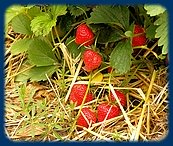
Growing strawberries on straw is also good to use when your plants are fruiting in the spring and summer. This keeps the fruit off the soil preventing them from spoiling and away from chewing insects who might get round to spoiling a good part of your crop. If you don't have straw, which can also be expensive, pine needles are a good substitute.
Make it a rule to mulch as soon as possible after the plants begin to blossom, and also after a good soaking rain. In this case the litter keeps the ground moist. If the soil immediately about the plants is covered when dry, the mulch may keep it dry - to the great detriment of the forming berries. It is usually best to put on the mulch as soon as the early cultivation is over, and then the bed may be left till the fruit is picked.After the berries have been picked, the remaining treatment of the year is very simple. Rake out the mulch, cultivate the soil, and keep the plants free of weeds and runners, if you are going to go with this system. Before hard freezing weather, protect again as before, and give the plants similar treatment the following spring and summer.
Under this system the same plants may be kept in bearing three, four, and five years, according to the variety. However, usually you only get the best out of your strawberry plants for the first 3 years, after which they will need replacing.
An enemy when growing strawberries, will be the birds. They just love to be tempted by those red, glossy berries and will do quite a lot of damage if you don't deter them.
You can do this be putting up canes of bamboo with tin foil strips attached to the tops, scarecrows, netting or even criss-crossing strands of cotton across your plants.
Renewing Old Strawberry Beds
If the old bed is just where you wish it to be, and has been prepared in the thorough manner described, it can be renewed in the following manner: When the old plants begin to decline, say in the third or fourth spring, a line of well-decayed compost and cow manure a foot wide may be spread thickly down between the rows, dug under deeply, and young plants set out just over the fertilizer.The old plants can be treated as has already been described, and as soon as they are through bearing, dug under. This would leave the young plants in full possession of the ground, and the cultivation and management for three or more years would go on as already directed.
Wood-ashes, as already mentioned, may be regarded as one of the very best tonics for the strawberry plant. Bone-meal is almost equally as good.
GROWING STRAWBERRIES - Diseases and Pests
If your leaves suddenly become brown and distorted it could be that your plants have a virus. The only option here is to dig up the affected plants and burn them.
To prevent the strawberry plants from being attacked by viruses and disease, it is wise to cut off all the leaves of each plant to about 10 cm above the crown after the fruiting season. These should be removed and burned, rather than put into the compost heap to prevent any contamination next season. Remove the straw as well, and burn that too. This is important if you are growing perpetual varieties that will crop year after year.
Mildew
Strawberry plants can also be affected by mildew. When this happens you will see that the leaves are covered in a fine whitish-grey powder, and the leaves will start to curl. If this happens, treat the plants regularly with a milk spray (one part milk to nine parts water). Full sun and good air circulation reduces powdery mildew.Botrytis
The disease botrytis, or gray mold, can also affect the fruit and leaves. Treat by removing the brown or soggy fruit. Reduce watering immediately. If this doesn't stop the spread, carefully remove so as not to spread the botrytis spores and burn.May Beetle

The chief enemy of the strawberry is the May beetle. The larva of this insect, the well-known white grub, has an insatiable appetite for strawberry roots, and in some localities and seasons is very destructive.
This beetle does not often lay its egg in well-cultivated ground, and we may reasonably hope to escape its ravages in a garden. If, when preparing for a bed, many white grubs are found in the soil, I should certainly advise that another locality be chosen. The only remedy is to dig out the larvae and kill them. If you find a plant wilting without apparent cause, you may be sure that a grub is feeding on the roots.
The strawberry plant is comparatively free from insect enemies and disease, and rarely disappoints any one who gives it the the attention it deserves.
GROWING STRAWBERRIES - How and When to Harvest
It should be remembered that all strawberries, unlike pears, should be allowed to mature fully before being picked. Many a variety is condemned because the fruit is eaten prematurely. If you get it right, you should be able to harvest strawberries for at least 6 weeks.After about a month of your strawberries flowering you should be able to harvest.
The strawberries are ready to harvest when they are red and have a gloss to them. Pick the fruit on a dry day when they are fully ripe after the morning dew has past and before 2:00 p.m. Never pick the berries when they are wet.
If you are going to employ pickers, make sure that you employ enough pickers to pick over all your beds once, every 2 days.
Commercial strawberry growers pack their fruit in quart containers packed in either 4, 6 or 8 box carriers, and these in turn make up 24, 32 or 48 box crates.
Tips for Harvesting Strawberries
- Pick your fruit only when ripe. For homegrowers these should be fully ripe, for commercial growers the fruit should be firm ripe and fully colored.
- Throw away any insect eaten fruit, mishapen or over-soft fruit.
- Pick the strawberry with at least a 1/4 inch stem and don't hold too many fruit in your hand at a time to minimize the chance of bruising.
- Keep the picked fruit out of the sun and into cold storage as quickly as possible after picking.
- Make sure you don't trample on your plants while picking.
GROWING STRAWBERRIES: How many strawberries from 1 plant?
Of course, your strawberry harvest will depend on the variety you have planted, the climate the plants have experienced during their growing time, how healthy they are and whether you have looked after them kindly. Assuming that all is well, you should expect to harvest 2-6 punnets of strawberries from each plant during the growing season.Countryfarm Lifestyles Tip: Grow borage, bergamot, daisies and other bee plants near your strawberries to improve pollination and increase your harvest.
As you can see learning how to grow strawberries is not that difficult!
WHAT DO YOU DO WITH ALL THOSE STRAWBERRIES YOU HAVE GROWN?
When growing strawberries there are several things you can do. Make your own jam, wine and home can your excess strawberries.JAM RECIPES for STRAWBERRY JAM, RECIPE 1
1 kg strawberries, washed, dried and hulled
juice of 1 lemon
1 kg sugar
Method.—Place prepared fruit and lemon juice (adding no water) into a pot and cook over a medium heat until fruit has softened. Stir often.
Weigh the pulp. It should weigh about 700g. If it is more reduce the amount by further cooking.
Add the sugar and continue as in the Basic Procedure, Steps 5, 6 & 7.
Let the fruit remain in the pot for at least 20 minutes before pouring into the jars. This will prevent the fruit from rising to the top.
JAM RECIPES for STRAWBERRY JAM, RECIPE 2
3kg strawberries1 kg jam sugar
Method.—Take the stalks from the strawberries and put them in a preserving pan.
Stir and boil for thirty minutes over a moderate heat.
Add the sugar; stir and boil for about thirty minutes longer, or until the jam stiffens.
Remove all the scum as it rises.
Put the jam into tightly and cover tightly.
HOME CANNING RECIPES FOR
STRAWBERRIES
Use equal weights of sugar and strawberries. Put the strawberries in
the preserving kettle in layers, sprinkling sugar over each layer. The
fruit and sugar should not be more than 4 inches deep. Place the kettle
on the stove and heat the fruit and sugar slowly to the boiling point.
When it begins to boil skim carefully. Boil ten minutes, counting from
the time the fruit begins to bubble. Pour the cooked fruit into platters, having it about 2 or 3 inches deep. Place the platters in a sunny window, in an unused room, for three or four days. In that time the fruit will grow plump and firm, and the syrup will thicken almost to a jelly. Put this preserve, cold, into jars or tumblers.
HOMEMADE WINE RECIPES for Strawberry Wine
Take of cold soft water, 7 galls.; cider, 6 galls.; strawberries, 6 galls. Ferment. Mix, raw sugar, 16 lbs.; red tartar, in fine powder, 3 oz.; the peel and juice of 2 lemons; then add brandy, 2 or 3 qts. This will make 18 galls.Another. - Take of cold soft water, 10 galls.; strawberries, 9 galls. Ferment. Mix, raw sugar, 25 lbs.; red tartar, in fine powder, 3 oz., 2 lemons and 2 oranges, peel and juice; then add brandy, 1 gall. This will make 18 galls.
Add your Comments on Growing Strawberries Here!
We have lots of pages where you can contribute to throughout this homesteading website, as you can see from the links below. We love hearing from our readers, and hope you will be one of those we hear from too. Please share any additional information, or ask a question on how to grow strawberries here, so that other may learn too! Just type in the form below, we will do the rest.
Leave a Comment
Do you have anything that you would like to add after reading this page? We would love to hear your thoughts. If you can add additional information to what has been written here you will be adding value to the website! No need to have any special skills - just type and submit. We will do the rest!
Other Comments
Click below to see comments from other visitors to this page...
Good advice Not rated yet
Thank you for the impressive information. Looking through all the "growing Strawberries" articles - this was the most covered article I ever read.
…
Don't miss out on our latest news and articles. Sign up for our free monthly e-zine!
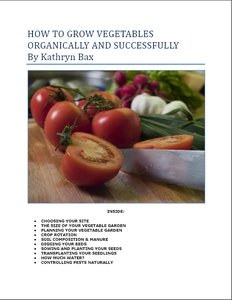 |
Email Address First
Name (optional) |
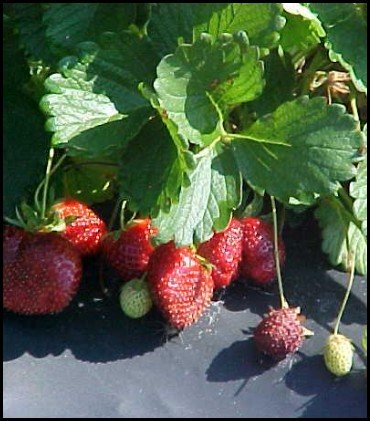









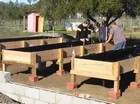
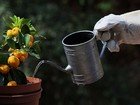


New! Comments
Do you have something of value to add? Leave me a comment in the box below.